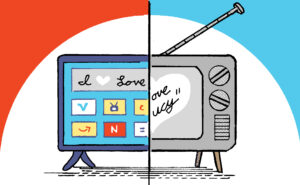Let’s Be Up Front
The TV industry sleepwalked toward disaster for years.
Upfront inventory prices went up for a decade while audience numbers plummeted. Lower supply, higher demand. Broadcasters could only blame Nielsen so much when its ratings were only reflecting back this audience decline.
Ever since 2020, TV upfront rates have declined. Partially, that’s post-2020 weirdness. At this point, however, the overall trend is undeniable.
“I don’t think it’s going to be a strong upfront by any stretch of the imagination,” David Campanelli, Horizon Media’s president of global investment, tells The Wall Street Journal.
Broadcasters all have their own ad-supported streaming services, reducing the scarcity concerns. Plus, they must battle for budget against newer players, like Netflix and Amazon Prime Video.
Advertisers can wait out the upfronts and bank on the scatter market and programmatic marketplace deals. Oh, and brands are in macroeconomic belt-tightening mode.
When valuable TV inventory cascades to the OpenRTB market, it can be an uncomfortable realization. For the 2023 FIFA Women’s World Cup on Fox, for instance, upfront sponsors paid more than $60 CPMs, or advertisers could cut guaranteed YouTube deals for $40-$45 CPMs. But some of that inventory fell to the open exchange, where it traded for about $12 CPMs.
Center Of Attention
Inconsistent metrics mean inaccurate results.
That’s why the IAB and Media Rating Council (MRC) recently released the first draft of their Attention Measurement Guidelines, a preliminary set of standards for measuring attention metrics.
Attention metrics are beginning to take root as a priority for buyers, along with viewability, according to Emarketer. The source of attention measurement data comes from three main places: biometric data (like heart rate or eye-tracking), survey data and contextual signals (such as scrolling speed).
However, unlike viewability, attention measurement methodologies differ per vendor, so the IAB’s and MRC’s attention measurements aren’t consistent across advertisers. The new guidelines are an attempt to “standardize methodologies for individual signals like eye-tracking or surveys” without governing which input signals will be used.
The guidelines are open to comment until July 12. (Chime in!) As for what comes next, well, we’ll have to just keep paying attention.
The Eye Of The Beholder
Speaking of attention metrics, rest assured there are even crazier ways to gauge online ad effectiveness than eye-tracking and biometrics.
At its NewFronts presentation on Thursday, Roblox touted its strong hold on its viewers’ (er, gamers’) attention, including “micro-changes in sweat activity” while viewing gaming ads, Digiday reports. Roblox also matched those results with post-campaign surveys to attribute nearly double the effectiveness in driving brand recall compared to social media ads.
On the other hand, these intangible, academic measurement methods also point to the degree of education required before mainstream marketers thoroughly embrace either gaming platforms or attention metrics.
Connecting the ad impression to a purchase or identifiable business outcome is the typical goal. “Attention scores are certainly important,” says Boaz Burns, associate director of innovation at the media agency Carat, “but it’s a very small piece of the decision-making matrix.”
But Wait! There’s More
GroupM US staff were told that up to 45% of employees could be affected in restructuring. It’s unclear if “affected” means layoffs, reassignment or something else. [Adweek]
Google considered and then rejected an idea for publishers to have an opt-out control for data scraping by AI web crawlers. [Press Gazette]
Google is expanding its “AI Mode,” including to take the place of the classic “I’m Feeling Lucky” button on search results. [Search Engine Roundtable]
Apple may raise prices on iPhones, but refuses to blame the move on tariffs. [WSJ]
AI, deepfakes and scams are making people more paranoid. [Wired]
You’re Hired!
Moloco welcomes Ned Samuelson as Global Head of Business, Moloco Commerce Media. [release]















